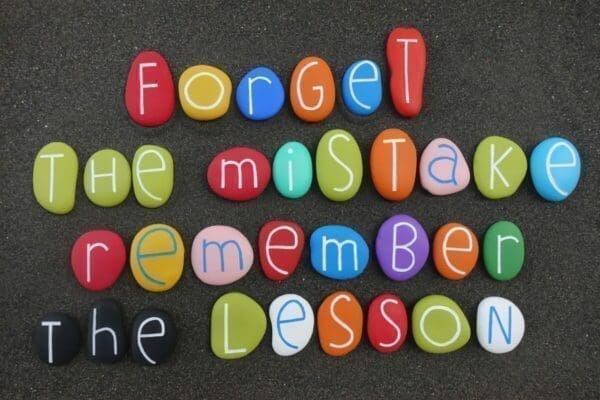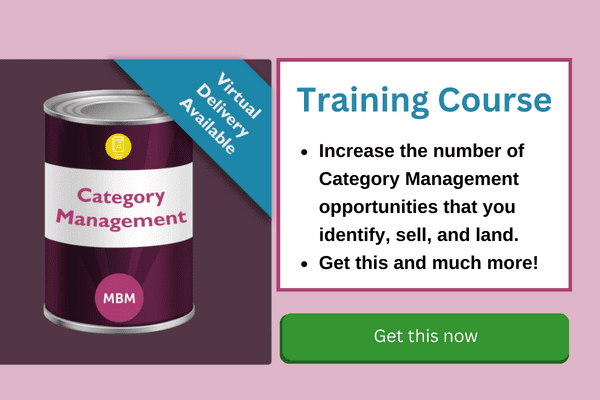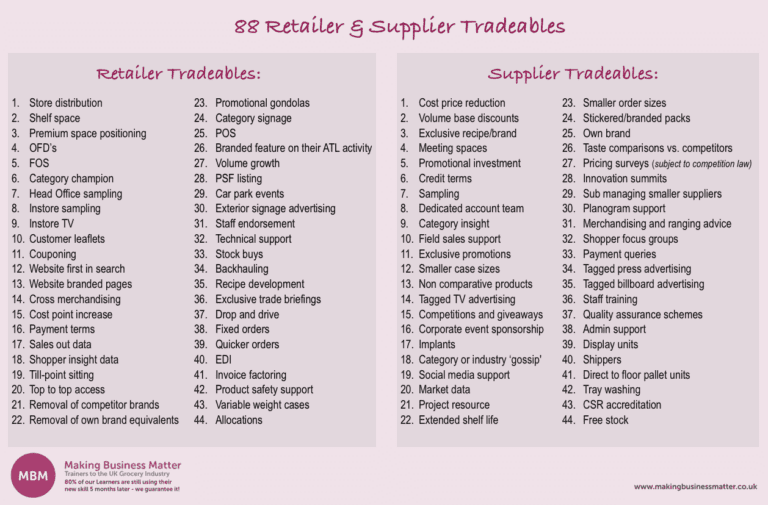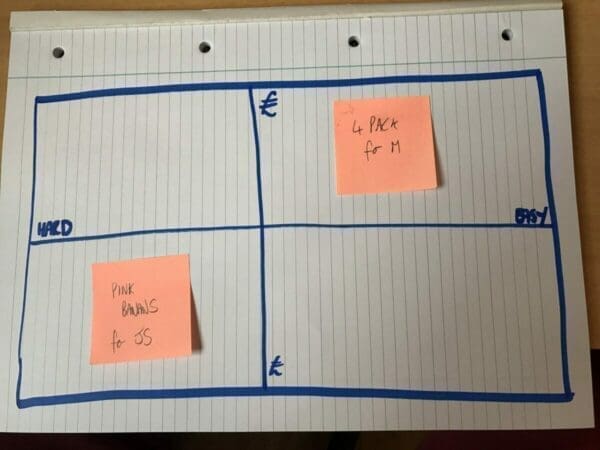Fix Those Mistakes With These Tips!
In the dynamic world of account management, the stakes are high, and the competition is fierce. Yet, surprisingly, some of the most critical mistakes are rooted in the basics. Here are four common mistakes account managers make that can derail even the most enthusiastic account managers and leave buyers rolling their eyes.
Jump Menu:
- 1- Know Your Enemy Customer
- 2- Don’t Sell What You Have – Sell What They Need
- 3- Prepare to Sell, But Don’t Forget to Plan to Negotiate
- 4- The Promo Calendar From Hell!
#1 of Mistakes Account Managers Make: Know Your Enemy Customer

It would seem so obvious, almost childish or even churlish to have to point it out. In our experience the single most common mistake that account managers make when sitting down in front of their buyers is a lack of detailed knowledge about them and/or the companies they work for – know the customer!
The very worst offenders are new, potential suppliers, often from overseas. They seem to have the impression that buyers are there as welcoming gatekeepers to show them and help them gain access to the UK market.
O, Not to Help!
Buyers are not genial travel agents or helpful mortgage brokers with a cheery ‘how may I help you’ smile and ‘what can I do for you today’ badge on their lapels. They are highly commercial, very focused business executives whose job is to make money by selling as many products as possible.
Too many new, fledgling suppliers miss this crucial point. They rock up to initial (and usually final) meetings with buyers with little or no knowledge of the detailed workings of the retailer they are targeting as a future customer. It is simply not enough to have a box of beautifully prepared samples!
Of course, yes they know who they are meeting with. The name of the main brand fascia. But we kid you not the number of times we have been asked ‘so how many stores do you have?’, ‘do you operate convenience stores?’, ‘can we supply on a weekly order basis to a single central depot please?’

Do Some Research! – Know Your Customer
It simply beggars belief that in this day and age of the internet, potential suppliers cannot or do not take the time to do some basic research into the company they are targeting as a future business partner. It is toe-curlingly embarrassing for the buyer to be asked such inane, straightforward questions and builds absolutely no confidence or credibility in the supplier’s ability to supply.
Sticky Learning ® is 7 times more effective than 1-day training courses. Plus, you will get a Chain of Evidence proving your Return on Investment. Discover soft skills training that changes behaviours long term.

You Need an In-Depth Understanding of How They Operate
As an absolute minimum, new potential suppliers must understand the supply chain they are hoping to enter. How will they meet the demands of the retailer’s stock and order supply chain system? This is especially important in fresh and chilled foods where the demands on a small new or startup supplier are considerable and often insurmountable. Wave deliveries, up to 3 or maybe 4 a day, 2 to 4 hour order to delivery lead times, double-digit numbers of RDCs (regional distribution centres) to get trucks to, super strict temperature and code life requirements, and stringent penalties if you make any sort of mistake.
Once you have the knowledge and confidence you can meet the supply chain requirements of the retailer you are hoping to sell into. You need to understand which channels you want to supply and how those channels work. Be it their superstore estate, their convenience estate or their home shopping and online operations.
What ranges are stocked currently in each? Are there opportunity gaps for you and your products? What shopper and consumer needs are you meeting? What is your ongoing activation and marketing plan to support your products? Which category drivers are you targeting? (if you want to know more or just want to know then read next month’s article!)
So, What About You?
Now for the vast majority of you reading this article, you will not fall into the trap of or fall for the ineptitude of not having a full and detailed knowledge of your customers.
You will either be ongoing, existing suppliers who by the nature of the fast-paced day-to-day operations of supermarket retailing will need to know how they operate. Or you will be a switched-on new potential supplier who has carefully researched your potential market. And the retailers you want to target as customers and routes to that market.
However, you can still make mistakes. Or if not at the very least improve upon what you are currently doing to make a greater beneficial impact with your buyers and so enhance your business with them.
Water Will Always Find the Easiest Route – So Should You
I was often asked as a buyer by some of my national account managers. ‘So please tell me how can I do more business with you. What would make me better than all the rest?’ My very simple and genuinely honest answer was always; ‘business is like a stream or a river, it will always flow down the path of least resistance. If you make doing business with me simpler and easier than anyone else, then you will get most of my business’.
Of course, you have to be at the races in terms of product, quality, price, investment, brand strength, innovation etc. But genuinely those national account managers working for those suppliers that knew my business almost better than me. And made my busy, stressful life easier, always got rewarded with a bigger slice of the category pie.

An Easy Life – Know Your Customer
So how do you make a buyer’s life easy? In the very simplest terms, it’s a bit like the stock market. They hate nasty surprises.
Whilst not their number one KPI, the service level is guaranteed to ruin a buyer’s day if it is not where it needs to be – and these days that’s 99.5% plus!
So, if you have a truck that turns over on the M6 one night and service levels of your on-promotion product in Scotland are at 60%. Do get that early morning text in before your buyer gets to the office. They won’t thank you for it. Their morning will be ruined. But they will tuck away somewhere at the back of their busy brains that you were the account manager who didn’t let them walk into a surprise barrage of email and telephone angst from irate Scottish store managers.
Knowing their business almost better than they do is always a great way of permanently endearing a buyer to his or her account manager. Their businesses are truly complex, intricate beasts. With a myriad of processes, procedures, departments and systems to navigate to make even the simplest in-store changes.
Part of the Furniture

Many younger, less experienced buyers may themselves not know ‘the system’ and how it works let alone how to ‘play it’.
The national account old hack who almost camps out in reception is as ingrained as the furniture and part of the woodwork. And who knows every shortcut in the book is gold dust to any young, ambitious, aspiring buyer who wants to get noticed and get on.
Every supermarket head office has them. That small cluster of national account managers who have been there, seen it, done it, got the medals and know what to do, who to talk to, when and how to make things happen.
It takes time, effort, energy and perseverance but we have all seen examples. Even in this data-driven age, where a savvy, on-the-ball account manager can get his or her products punching way above their true market share weight.
Don’t Forget the Basics – Know Your Customer
It is often the simplest of things that leave the right or more often wrong impression in your meetings with supermarket buyers.
Getting their name right for example would you think be a basic requirement? But believe me, it has happened. Not very endearing to be called a Kevin or Richard or even Dick – when you aren’t!
Building rapport is important, almost as important as building a business relationship. Rapport is that ability to socially interact in an almost invisible, fluid way that builds engagement, trust, respect and familiarity. It’s a difficult skill to judge and master. Those account managers who can carry it off flawlessly are gold dust to their respective employers. Those that can’t come across as awkward, embarrassing or even crass.
LinkedIn Do’s and Don’ts
LinkedIn is a wonderful tool. Within seconds you know your buyer’s full name, where they live, and where they went to school and college. Also where they have worked, how fast they have progressed and often their favourite hobby, sport and team.
Be very wary of how you use this mine of information though. Think of it from your own perspective, how would like to be greeted with an in-depth run-down of questions about your life, family, career and hobbies?
The key is judgment – judge how open your buyer is to the ice-breaking conversation as you walk from reception to the meeting room or as you stand awkwardly in the elevator. Most buyers are natural extroverts and so love to talk and chat, especially about themselves!
However, don’t press and harry them beyond where they are comfortable. You will know over time what is within and what is out of bounds. And even if how well City or Spurs did at the weekend remember – and find out – they may just be a massive rugby fan!

Old News is Bad News
You know just how fast-paced their businesses are. You supply them to within quite incredible tolerances. However, it is sometimes easy to forget just how fast-paced and how quickly they can change.
You as manufacturers, even of short shelf life chilled products, will potentially still think and plan in terms of weekly or monthly periodic cycles because that is how your business is set up.
Your customers however think by the minute and hour. Store managers receive sales updates by category every two hours or so throughout the day on their smartphones and tablets. By department, they see sales day on day, week on week, year on year. Consequently micro manage the store assortment for maximum sales and minimum waste and cost.
Buyers think and plan daily and weekly. Daily sales, profit and service levels are the normal big three first things they look at each day. In produce and chilled foods, speed of decision-making and response to weather changes and trading patterns is the difference between almost hitting budgets and massively missing them.
So to be their go-to account manager. The one that makes their life just that little bit easier than all the rest, you need to be on top of every single impact and change to their category performance. Weather, bank holidays, seasonal events, paydays, elections etc. etc. etc. And most importantly providing them with the solutions to the problems those fast-moving issues present them.
And Finally Know Your Customer
One final top tip to be the up-to-the-minute, on-the-ball, responsive, proactive account manager.
When you are sitting in their reception – inevitably for 20 minutes beyond the appointment time – take the time to read the news – NamNews!
Grocery retailing is evolving at a frightening pace – planned mergers, banned mergers, takeovers, customer service initiatives, checkoutless stores, hirings and firings. You never know who may have just bought who, who has divested of what or even who has just got a bullet. Better to know before you walk into that meeting room and potentially make a chump of yourself!
Part 1 Written by Darren A. Smith for KamCity.
#2 of Mistakes Account Managers Make: Don’t Sell What You Have – Sell What They Need

The very low point of my week as a supermarket buyer often came at 4pm on a wet, dull, winter Thursday.
Having already had seven boring – to the point of wanting to chew your own feet off – presentations from suppliers that day, up comes number eight, the last of the day – what a relief!
The NAM quite literally bounds into the room like Tigger on speed, super excited and hyper-energetic – so much so that you wonder what are they on? – and please can I have some?
In their breathless excitement, they manage to multi-task shaking hands, setting up a laptop, projector and screen and extracting various calculators, pens and notepads from their case. All whilst bombarding you with the most teeth achingly dull and predictable opening question ever created – ‘So tell me, how’s business?’
There then follows the most depressing noise a buyer will ever hear. The hefty, dull, thud of a 150-page presentation deck onto the table. Now it’s no longer your feet you want to chew off.
The presentation proceeds, a muddy trudge of one-way trench warfare, a barrage of seemingly random facts, figures and features. A true pebble dash of every possible feature of their wonderful, phenomenal, groundbreaking, earth-shattering new product, initiative or plan.
Little wonder buyers have a reputation for getting bored and playing silly tactical games such as yawning, playing on their phones, walking out or even throwing the supplier out!
What are Their True Needs?
The art of successful selling is to not sell what you have but sell what someone needs.
If you can find what truly motivates your buyer and match that or those needs to a feature of your product or plan then your sale should be a shoe-in. Plus it will take less than 10 slides and under 20 minutes of your and their time – relief all around!
Let’s take a very simple hypothetical example. Let’s sell a 500ml bottle of premium branded still bottled mineral water with a suitably posh French-sounding name – ‘Perrian’ – to two very different buyers.

Our first buyer is a light aircraft pilot who tragically crash-landed over the Sahara Desert three days ago. Is he interested in a 150-page feature fest detailing the provenance of the brand, the fact that the water is filtered to purity for 10,000 years through the snow-covered rocks of the Alps, the way the bottle is moulded to evoke warm memories of Mont Blanc on a perfect winter sunrise?
NO! – he needs to rehydrate quickly or he will die – he needs water! – and at what price? – well in this instance once you have pointed out that your bottle of water will rehydrate him and save his life he will quite clearly pay any price you name.
Hypothetically…
Now let us take our second hypothetical buyer – remember our product – ‘Perrian’ – does not change.
Here we have a young chap who works in the financial services industry in beautiful Milan. He earns around 3 million Euros a year, and always likes to be seen wearing the latest and best Armani suits and Ray Ban shades whilst he takes his leisurely two-hour lunch at a super trendy sidewalk restaurant in the heart of the historic city centre.
Does our buyer number two need life-saving rehydration?
NO! – he needs to be sold the super premiums of the brand, as voted Europe’s trendiest water by Vogue magazine for five years running, as exclusively drunk by celebrity X and La Liga superstar Y and with calcium and other minerals that help keep a perfect youthful complexion.
So avoid the pebble dash, feature fest – it will just bore the pants off your buyers and do no justice to all the hard work you and the bigger team have put into your product or idea.
Spend time finding out their needs, what drives and motivates them and then sell the features or parts of your product or idea that best meet those needs. And as we have just seen, if you can nail a ‘killer need’, something they absolutely have to have to meet a core need, then your sale is done and price becomes almost immaterial
What Needs do I Sell Against and Where Do I Find Them?
There are three types of needs you can sell against – Business, Shopper and Personal needs. Each can be as important as the other or used in combination depending on how important the needs are to the individual buyer and how well your product or idea meets them.
1. Business Needs

Business needs are those commercial business drivers that make a supermarket business successful. There are clearly the generic, timeless ones: Sales, Margin, Share, Availability, Price Competitiveness etc. However, you need to find which are currently on top of their agenda so that your sale comes across as fresh, up-to-the-minute and dynamic.
So where to look? Well, the good old internet is a great place to start particularly if the customer is a PLC. Go to the investor relations section of their corporate website. You will find a whole wealth of information about their plans and strategies. They have to report performance to their investors – the City – every 12 weeks, so there is always a ‘Plan’ – be it a 3-step, 5-step, 7-step, growth, recovery, springboard or transformational plan – whatever it is it will be detailed in easy to understand and digest, PR speak.
Key Strategies
Play back any of these plans and strategies that your product or plan dovetails with to your buyer and it is a very brave or foolhardy buyer who says the corporate strategy is wrong!
Other great sources of business needs are people! – talk to your buyer, and use advanced questioning techniques to garner the key information you need. Speak to store managers and colleagues – they love to have a ‘whinge’ about what Head Office, sorry the ‘Support Centre’ is up to.
Keep fully up to date with the latest changes – their businesses change by the hour and day – particularly so in these increasingly challenging times – have an up-to-date news feed for the industry – NamNews why not! – and read it regularly.
2. Shopper Needs
Selling effectively against the needs of their shoppers is the new ‘gold rush’ of 21st-century selling and something you cannot avoid or bury your head in the sand against. It is quite literally transforming the traditional roles of buying and selling.
The explosion of data derived from shopper loyalty programmes – Clubcard, Nectar, Sparks Card etc. etc. – has exponentially increased the amount of detailed behavioural data the big supermarkets and online players have about their shoppers – your customers.
Once they have captured a shopper’s postcode and permission they can link the contents of their shopping basket not just to each other – nappies are most often bought with 4-pack lager?! – but to demographic, life stage, lifestyle, affluence, health etc.
The new 21st century ‘Gold Rush’ is the ability to take this unimaginably huge mass of data that has been collected and sift and sort it for ‘nuggets’ of insight that point to what drives shoppers to purchase what in particular and where – i.e. their needs.
Shopper Loyalty
All the supermarkets are locked in a battle for shopper loyalty. Loyal shoppers are the cheapest to market to – they are quite literally in their stores. They are the most profitable, spending, by definition, the largest proportion of their weekly grocery needs with that particular supermarket and with over 80% of UK grocery controlled by the big 5 there is little growth to be had elsewhere by either geographic expansion or shopper switching.
So, loyalty and driving the value spent by loyal shoppers is the key battleground of UK grocery retailing. Those suppliers that present solutions to shopper needs that drive incremental sales and profit are those suppliers getting the new line listings and growing their own volumes – and hopefully profits too.
Unfortunately, supermarket shopper data does not come cheap and perversely often prevents those very suppliers they are trying to encourage – the small, innovative, unique, point of difference (as opposed to Taste the Difference!) brands and products – from accessing the shopper data that would better inform even more targeted product initiatives.
As a supplier, you need to jump on board the insight bandwagon in whichever way you can – garner what data you can or can afford and find those shopper insights, those shopper needs that your product or idea can fulfil – an open door will await.
3. Personal Needs
It may not always seem the case but your Buyers are human! They have the same basic career and job drivers as everyone else – to progress, to look good, to be the best, and to be recognised and rewarded for effort and success.
Selling against a buyer’s personal career and job drivers is not always the easiest to identify. Yet alone sell against but get it right and it becomes hugely effective. Quite literally getting to the core of what they are about, what drives them.
Much easier to help out a young, keenly ambitious buyer in their early career rather than trying to motivate the 30-year veteran who is simply clinging on the accrue the final pieces of that now-extinct final salary pension.
A Buyer Who Will Love You
However, get it right, and meet the right personal needs at the right time with the right solution. You will have a buyer who will quite literally love you and your brands forever.
It has almost reached urban mythical status. But the very astute NAM who arranged to bring six examples of his brand icon – cute, white, Labrador puppies – to a ‘puppy petting session’ at a very large supermarket’s Head Office right in the middle of particularly difficult negotiations managed to create a moment of opportunity by quite literally ‘softening’ the other side up.
Head Office sampling events, sponsored canteen lunches, giveaways in store, win a ‘Mini’ shopper competition. Anything that is exciting and different but most crucially allows a young, ambitious and competitive buyer to tap out the…… ‘To All Staff’ email – showing what a bright, talented, going places young executive they are by arranging something so novel.
And you never know they may just get that one email reply they really want, from the CEO or MD with a …..‘well done young man/lady. Just the sort of person who will go far in this business. You must drop by for a quick coffee and chat – speak to my assistant’.
When Fishing – Choose the Right Hook

Effective selling is about meeting needs. Which feature, aspect or element of your product or proposition best meets their most important Business, Shopper or Personal needs?
Think of it like fishing. You don’t go out to catch a shark with a fly fishing hook. You don’t go to catch a trout with a huge great anchor-sized hook.
Choose the right hook for the fish you want to land. It’s then as simple as slowly reeling them in. Using less than 10 slides and in under 20 minutes and not asking them ‘So how’s business?’ – pleeeeese!
#3 of Mistakes Account Managers Make: Prepare to Sell But Don’t Forget to Plan to Negotiate

No is Bad, Yes is Good…. But
‘No!’ – the one, tiny word guaranteed to strike terror into the very heart of any account manager. Buyers are there to do deals – it’s their job title after all! – You may not think it, but they really don’t like to say ‘no’ too often. Saying ‘no’ too regularly can lead to missed opportunities and investments which can then be subsequently taken up by their competitors. Even worse and often terminally career limiting, the result of too many ‘nos’ too often can be empty shelves. So plan to negotiate!
They much prefer therefore to say ‘yes…but’ quickly followed by trotting out one of the oldest tactics in the buying book. The venerable ‘Oliver Twist’ tactic of saying ‘Yes, but……. I want more!’
Negotiation is Good
We have spent the last two articles in this series examining some of the common mistakes salespeople make when meeting with and selling to buyers. Now, we are going to focus on the natural outcome of a successful sell. But one that account managers (in my experience) spend far too little time thinking about and preparing for is negotiation.
Negotiation is only possible if you have successfully sold. That is you have convinced the buyer that your proposition or plan meets at least one if not more of his or her shopper, business or personal needs.
So, when a buyer asks you for ‘more’ you should vigorously shake their hand and profusely thank them! They are signalling that you have successfully sold and now it is simply a matter of negotiating the final deal.
A Game of Two Halves
So do prepare great, needs meeting, selling stories. But do not forget to spend at least as much time planning how you will plan to negotiate a mutually profitable deal following your successful preparation to sell.
At Making Business Matter I meet and see hundreds if not thousands of account managers each year at our workshops and courses. Too often I see fantastic and superbly prepared selling decks in all their PowerPoint glory. But rarely see a well thought through, formally laid out, costed negotiation plan with clear tradeables, positions, options and fallbacks.
Our advice is that you spend at least as much time planning your negotiations as you do in preparing your selling stories, decks and presentations. Think of it as a game of two (equal) halves if you like. You don’t want to play a blinder in the first half, get ahead of the game only to find yourself comprehensively outplayed, outgunned and inevitably beaten in a frantic second half of negotiation.

You Can Never Have too Many Tradeables
Tradeables are the ‘oil’ of any negotiation. They allow any potential conversation to flow smoothly, giving both sides that classic and much sought after but often not achieved ‘Win-Win’ outcome. However, in my experience, too often account managers fail to go beyond thinking of and planning the most obvious tradeable. That is, those intrinsically close to the deal such as cost price, store distribution numbers, number of facings and shelf positioning.
You should never enter a negotiation following a successful sell with a supermarket buyer without planning and arming yourself with at least 20 if not closer to 50 tradeables that you can use to efficiently and effectively ‘oil’ the negotiation process.
Trade High Value and Low Cost
You are looking to identify those High Value to you but Low Costs for them to give tradeables and vice versa. Those – Low Cost for you to offer but of High perceived value to them – tradeables.
So where to look? Well, buyers are constantly under pressure to deliver for their respective businesses over and above their core KPIs of sales, cash margin and market share.
They are constantly being harangued by different departments within their own business for support and investment from their suppliers. Buyers see these ‘requests’ – voucher funding, shopper leaflet investment, in-store sampling demonstrations, prizes for shopper competitions and the like as a never-ending row of ‘monkeys’ on their shoulders. A long line of tiresome, time-consuming and (to them) non-critical to their day job, mini hassles to be agreed upon and negotiated.
These are the tradeables to identify. Buyers will often be willing to trade these for less than their true value to you just to get a tiresome, jabbering ‘monkey’ off their seemingly endless, incessant ‘to get’ list.
Find Your Tradeables in Store
You will find these tradeables by spending a good morning or afternoon walking one of their larger stores.
Don’t just visit as you would normally the aisle stocking the category you happen to supply. Additionally, walk all the ‘big’ category aisles with lots of marketing activity going on. Beers, Wines & Spirits, Frozen Foods, Soap Powder, Cereals, Hot Beverages, Fruit & Veg, Meat. Take careful note of all the ‘stuff’ that is going on. POS, barker cards, shelf wobblers, floor stickers, hanging boards, category signage, category fins, header boards, feature space, new line space, the list is almost endless.

Additionally, also look at all the other activity going on in and around the store – advertising on trolley handles, checkout queue dividers, till roll advertising, instore radio, instore TV, petrol station hoardings, car park hoardings etc. etc. etc.
All of these are tradeables that you can use as the oil to efficiently plan your negotiation. Yes, there may indeed be a rate card ‘gate fee’ attached to them. But often you will be able to get more bang for your gate fee buck. Or negotiate the gate fee down if you are helping a hassled, harried, time-poor buyer lose a few of those monkeys lining up along their shoulders. Not only will you get a great deal. You will build a much more effective rapport and relationship with a very grateful buyer!
Buyers are There to Buy!
Buyers love doing deals – it is in their job title after all!
Often a big intractable, problematic negotiation with both sides seemingly entrenched in their respective positions can be freed up by introducing new additional and often unrelated tradeables into the negotiation.
Just as in big political and military stand-offs, it is often the smallest of deals that help to melt the ice and break the log jam of impasse. Thereby allowing the bigger deal to progress.
Plan to Negotiate – Multiple Negotiations
This is also true when selling and negotiating at more senior levels and with complex multi-level negotiations where you may not be able to agree on what you want with the buyer. Because they don’t necessarily have the authority or permission to say ‘yes’.
It is very rare these days that you will ever get an agreement from a buyer at a single meeting. There is the selling presentation itself, inevitably followed by numerous follow-up emails and telephone calls. Before (if you are lucky) a final confirmatory meeting or notification. Remember each of these interactions is an opportunity for buyers to negotiate further. Often utilising the ‘agreement by downgrade’ or more memorably known as the ‘death by a thousand cuts’ tactic! You need to be equipped and armed with plenty of smaller, easy-to-transact tradeables for each of these small steps towards the end game of the negotiation. Remember these mistakes account managers make.
How Long and How Far Up the ‘Tree’ Will the Chess Game Go?
For bigger, more complex, multi-level negotiations think of the process as a big game of chess. You need to ensure you look ahead in your planning. Try to predict just how many ‘chess moves’ there will be in the negotiation you are entering.

Ask yourself. Is it a relatively straightforward, simple one or two-meeting step new line listing negotiation? Or is it a complex cross-category, multi SKU, multi-mechanic, annual trading plan negotiation with the added fun of a price increase?!
If so, you need to plan for at least a 3 to 5 meeting chess game negotiation. With each step potentially escalating up the supermarket’s commercial hierarchy at each step.
A simple, super handy rule of thumb. If the deal or sell you are trying to get an agreement for accounts for 10% or more of your buyer’s category sales. Then there is a very high probability that your buyer will have to involve his or her boss in the final negotiation and/or decision. The same 10% ‘rule’ applies to the buyer’s boss and the value of their total category remit and so on up the commercial hierarchy to board level should you be ‘fortunate’ enough to enjoy sales that account for 10% of your customer’s turnover!
Click the image below for a larger version:

Probability of Negotiation
So, calculate the probability of and how far your proposal will have to travel up the commercial hierarchy. Plan your negotiation tradeables accordingly.
You need to have enough tradeables to last through to the very last meeting and ensure that you keep some of the best. Those that are of the highest perceived value to either side – up your sleeve for that final sealing of the deal moment.
Remember that senior executives—especially senior buyers, category directors, trading directors, and commercial directors—want to be seen as wearing the ‘Superman’ underpants to show their teams how it’s done. As they heroically step in and smoothly bring the negotiation to a successful and beneficial close!
So always ensure you plan carefully which tradeable to introduce and when. As the chess game progresses, and leaves sufficient and sufficiently (perceived) valuable tradeables for the last stages of the negotiation.
Get into the Habit of Regularly Refreshing Your Tradeables
You can never have too many tradeables in your negotiation toolbox. Always have a running list of at least 20 and preferably something nearer 50.
Spend a good day with the wider account team to brainstorm and generate as many tradeables for both sides as possible. Remember to think for both ‘sides’ – those you can offer and those you want back in return.
A simple Boston High/Low matrix on big sheets of paper with Post-its is a very interactive, practical way of getting the team thinking and working together to generate tradeable ideas.

Once generated, costed and valued keep them fresh and refreshed regularly integrating them into account discussions and planning.
More Yes’s, Fewer No’s …. I Want More…. Less
The most successful account managers spend at least as much time planning to negotiate as they normally would preparing their selling decks and stories. Get into the habit of allocating a 50/50 balance to your selling and negotiation preparation and planning time.
Remember to profusely thank your buyers as and when they ask for more. They are after all signaling that you have been successful in your sell. They can see in their mind’s eye your idea or proposition on their shelves. It’s simply a question of how you now effectively negotiate a mutually beneficial deal to get your idea across the line and into their stores.
Action: For even more useful content on negotiations, check out our ultimate guide on negotiation skills.
Part 3 Written by Darren A. Smith for KamCity.
#4 of Mistakes Account Managers Make: The Promo Calendar From Hell!

Whilst most typical people – Buyers and NAMs – are relaxing and sunning themselves on beaches around the world. There is that strange pale-skinned breed of people who are busy working away on the promo calendar deep in the sunless bowels of the big supermarkets on next year’s budgets. Yes, the bean counters!
Most of the Big Six supermarkets’ financial years start in the first three calendar months of each year. Therefore budget and business planning starts just before the summer break. And gets going in earnest with the heavy thud of the ‘top-down’ corporate budget as a cheerful welcome back from holiday for Buyers, lots of love, courtesy of the Finance team!
This means for the chillaxed, sun-bronzed account manager returning from their long, lazy summer sojourn, September is the time to start in earnest strategic account planning for next year for their key supermarket accounts.
The planning window is not long, and this year will be severely impacted by the ongoing ‘B’ crisis. In average times mid-October half term is the benchmark date by which most supermarket Buyers will have had their category targets set for the following year. And will be thinking about and wanting to hear about plans for hitting those targets for next year.
Once you get past mid to late October the Christmas season starts to take over your thoughts, efforts, time and energy. So the time to start to plan and subsequently present your account plans is pretty much from now (late August) onwards.
The ‘Crystal Meth’ of Retailing
The most important thing to latch onto when creating your strategic account plans is to not forget to take absolute account of the ‘Crystal Meth’ of retailing. The retail drug they are absolutely addicted to. Try as they might cannot kick what is a decades-old habit.
Simply put they are like-for-like junkies. The whole of their supermarket world revolves around their ability to positively lap last year’s peaks and troughs of sales. As many suppliers will all too painfully know this year has had the mother of all hangovers from last year’s record-lasting heatwave and the World Cup.
They will all budget to increase their like-for-like sales by at least enough to cover the increase in their expected costs and most importantly their biggest single cost – store staff wages. In the good old days, new store openings gave them huge sales boosts. But they are now very much a trickle rather than the raging river of the nineties and noughties. Add to the like-for-like increase a hefty dose of cost savings and the inevitable margin task for the buying teams and viola you have one perfectly presented top down. Like-for-like driven category budget for your buyer to lose countless sleepless nights over in the coming 12 months.

Plan to Beat the ‘Highs’ and Exploit the ‘Lows’ with the Promo Calendar
So, as an account manager be very aware of your buyer’s like-for-like ups and downs across the year. When did a promotion you took part in produce a huge spike in sales? What events – Royal weddings, sports tournaments, heatwaves or conversely for some categories abnormal cold snaps drove your and their business?

You can bet your next month’s salary that you must match and exceed those sales spikes in next year’s plan. Your Buyer will be hugely disappointed if you omit or forget any!
The opposite is also true and perhaps of even greater importance. Where are the lows, the dips in like-for-like sales as a result of poor weather (or good weather) of the annualising effect of the previous year’s events? These are your and the Buyer’s opportunities to create like-for-like spikes against last year’s lows. Find the lulls and dips and plan to exploit them with sales-driving activity. Your Buyer will be delighted and may even thank you!
The Promo Calendar From Hell!
Having taken careful note of their customer’s like-for-like highs and lows the erstwhile and intrepid account manager now goes off to come up with a cunning plan to lap the highs and exploit the lows. So where to start?
Unfortunately, in my experience, it’s usually via a trip to the marketing or brand team to get a copy of next year’s ‘activity calendar’. Carefully laid out by month, a finely honed piece of art, a beautiful matrix of all the wonderful things that your business is going to activate next year.
As a Buyer, I used to quite literally scream when (normally at around slide 32 of 90 in the annual business planning presentation from a big brand) presented with the promo calendar from hell!
Even if the promo calendar was tailored to my business and my promotional periods (always a help – but not always the case!) it was just a blur of ‘stuff’. Half-price this here, billboard advertising there, MONP in May (money off next purchase). NPD in November and to cap it all TV in September – hurrah! And with 120 GRPs! Even better!
The Language of WopFopPen
Now I am sure I have exaggerated to make my point. In today’s sharply focused world of selling, none of you Account Managers reading this would ever make the mistake of just presenting an activity plan to your Buyer!
The right approach of course and it is something we discussed in part 2 of Mistakes Account Managers Make, is to ensure you present not only what your activity plan is but crucially what it will do for their category and their shoppers.

Your plan will be designed, hopefully, to drive improved sales growth into their category so that they can sell more and make more profit on the back of it. Well, there are only three ways of driving growth in a category. You either sell more volume or value of the product (Volume weight of purchase or value weight of purchase). Get shoppers to buy more often (Frequency of purchase). Or get new shoppers into the store or into the category (Penetration).
Your Buyers will want to see which of these three levers your planned activities will ‘pull’ against. The big 4 – Tesco, Sainsbury’s, Asda and Morrisons are all about loyalty. Retaining their existing substantial numbers of customers. Driving up the weight of purchase and/or frequency of shop of those loyal customers. Aldi and Lidl conversely are still in the ‘land grab’ phase of driving new customer penetration. With some added upselling (value weight of purchase) sprinkled in for good measure.
Which of the ‘Levers’ You are Going to ‘Pull’ in Your Promo Calendar
So, any modern strategic account plan should show them not only what you are planning to do. But show what your plan will do to drive shopper engagement via each of the aforementioned ‘levers’ of growth. Each entry on the activity on the promotional calendar should have alongside it which lever it will pull and by how much.

For example, Multibuy 2 for £1 promotion in April to drive weight of purchase, estimated £200k incremental revenue. New Avocado flavour variant NPD launch in September to drive penetration of health-conscious shoppers, estimated cannibalisation 5%, nett incremental revenue £100k. Money off next purchase on pack voucher in April to drive repeat purchase and frequency estimated £50k incremental revenue.
Take Them on a ‘Journey’
Be even more motivating and impactful. Show them that your activity plan is coordinated and specifically tailored to their business and shoppers.
They don’t want a brand plan. Your brand is only a (small) part of their category plan. Be holistic and whole-category friendly. Any category growth you generate, especially if you are a brand leader will benefit you as much. If not more than any of the other, be they branded competitors or own label manufacturers.
Make your plan specific to them and importantly their accounting calendar. Of course, you can overlay ‘national’ or branded activity but again be clear about what it will do for their shoppers.
The bit they will be most interested in is the customer-specific activation or activity plan. What are you going to do to drive their category sales by better engaging with their shoppers and shoppers-to-be? Taking them on a shopper ‘journey’ is the way to demonstrate not only that you are serious about shopper-led insight. But also serious about supporting them.
For example, with NPD show them a product ‘life’ journey that tells them what at each stage you are attempting to do to drive shopper sales volumes. A free sampling at the launch outside key stores to drive awareness. Half-price promotion after 4 weeks to drive pick up in-store. A 2 for £1 promotion after 12 weeks to drive the weight of purchase. Ddual merchandising in high-traffic bakery aisle after 16 weeks to drive impulse pick up and frequency. Add a cost and expected value return for each of these activities and Robert will be your proverbial uncle!
‘But What About My Margin!’
A shopper lever-based approach to a healthy and growing sales line is of course the best way to offset the inevitable ‘where’s all my margin’ whinge. Develop your ‘Selling More’ plan as we have discussed. You can then have, hopefully, a sensible ‘Making More’ discussion or negotiation with the Buyer. To give them comfort that your plan will also deliver their budgeted margin task be that % and/or total cash margin.
I always used to love and love the account managers who presented them to me. A neatly drawn and comprehensive waterfall chart, blocking up, piece by piece, activity by activity just how much sales and cash each element of the plan would deliver. And how the combined effect of all the activities moved me from outturn this year to the budgeted target for next year.
I often used these waterfall charts as the basis of each and every review meeting with the account manager. It gave us both a focus, a target and joint responsibility for the outcome. For the buyer, a sense of relief and confidence that at least one major supplier in the category could be trusted to deliver a plan that helped me achieve my targets. For the account manager, an enthusiastic buyer who would help achieve your objectives in a proactive and positive way.
How to Eat an Elephant…

Clearly any plan is out of date the very moment the inkjet hits the paper and a target is only a target. To be beaten or missed is rarely perfectly hit! So I would ‘chunk’ up all the activities with key suppliers into quarters (the best way to eat an elephant supposedly!). Then only worry about the upcoming quarter. What do we still need to do to make things happen? Then review the success or otherwise of the previous quarter. And what mitigating additional activities would need to be added in later in the year if a quarterly target had been missed.
Sounds simple and it is. When done with some proper planning and thought and patience……
Finally, that wraps up this article on Mistakes Account Managers Make. If you enjoyed it, do share it on Linkedin.



